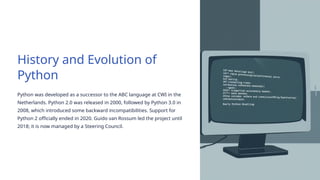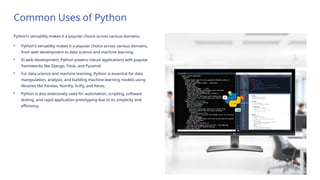Introduction-to-Python-Programming-Language (1).pptx
- 1. Introduction to Python Programming Language Python, created by Guido van Rossum and first released in 1991, is a high-level, general-purpose, and interpreted programming language. It emphasises code readability through its significant indentation. The latest stable version is Python 3.13.3, released in July 2025.
- 2. History and Evolution of Python Python was developed as a successor to the ABC language at CWI in the Netherlands. Python 2.0 was released in 2000, followed by Python 3.0 in 2008, which introduced some backward incompatibilities. Support for Python 2 officially ended in 2020. Guido van Rossum led the project until 2018; it is now managed by a Steering Council.
- 3. Why Learn Python? Summary Top 3 Ranked among the top 3 programming languages globally. Easy Beginner-friendly, yet powerful for experts. Versatile Used in web, data science, automation, AI, and more. Community Vast ecosystem of libraries and a large supportive community. Fast Ideal for rapid prototyping and production-ready software.
- 4. Key Features of Python Multi-Paradigm Supports procedural, object-oriented, and functional programming. Dynamic & Automatic Dynamic typing and automatic memory management via garbage collection. Extensive Library Comes with a vast "batteries included" standard library. Cross-Platform Runs seamlessly on Windows, macOS, Linux, Raspberry Pi, and more.
- 5. Common Uses of Python Python's versatility makes it a popular choice across various domains. • Python's versatility makes it a popular choice across various domains, from web development to data science and machine learning. • In web development, Python powers robust applications with popular frameworks like Django, Flask, and Pyramid. • For data science and machine learning, Python is essential for data manipulation, analysis, and building machine learning models using libraries like Pandas, NumPy, SciPy, and Keras. • Python is also extensively used for automation, scripting, software testing, and rapid application prototyping due to its simplicity and efficiency.
- 6. Popular Python Libraries and Tools Pandas For data manipulation and analysis. NumPy For numerical computing and array operations. Matplotlib For creating 2D/3D data visualisations. Requests Simplifies HTTP requests for web communication. OpenCV-Python For computer vision and image processing. Keras A high-level API for building deep learning neural networks.
- 7. Python Syntax Basics • Simplicity: English-like syntax with indentation defining code blocks. • No Semicolons: Uses new lines to end statements. • Structures: Supports functions, classes, loops, and conditionals with clear readability. • Interactive: Interpreter allows immediate code execution and testing. # Example: Hello World in Pythondef greet(name): return f"Hello, {name}!"message = greet("World")print(message)
- 8. Important Python Keywords Conditional if, else, elif Looping for, while, break, continue Definition def, class Asynchronous async, await Flow Control return, yield, try, except, finally These reserved, case-sensitive words define program structure and control flow, and cannot be used as identifiers. Examples also include: True, False, and None.
- 9. Thank you
Editor's Notes
- #5: Python's versatility makes it a popular choice across various domains, from web development to data science and machine learning. In web development, Python powers robust applications with popular frameworks like Django, Flask, and Pyramid. For data science and machine learning, Python is essential for data manipulation, analysis, and building machine learning models using libraries like Pandas, NumPy, SciPy, and Keras. Python is also extensively used for automation, scripting, software testing, and rapid application prototyping due to its simplicity and efficiency.








